Last week, we examined Saviors of Uldum neutral cards from the perspective of a budget player. When putting together a cheap deck, you may often want to pass up on cards that are widely used in more expensive decks, because you lack the synergies needed to make them shine. Likewise, you may want to include some cards that are not used as often, because they work better alone than some more expensive cards. Furthermore, even when you are putting together a slightly more expensive deck, there are big differences in deck costs: decks in the six-to-eight thousand dust range are much easier to put together than decks that cost more than ten thousand dust, and may require completely different cards as well.
With this perspective in mind, let’s take a look at what Saviors of Uldum has to offer for each class!
Druid
The main Druid archetype in the current meta is Quest Druid, but it is an expensive deck, with a cost of up to 15,000 dust. The majority of the Druid set goes directly into that deck, including all the Legendary and Epic cards from the expansion, and their other uses are severely limited. Basically, the Saviors of Uldum Druid set has been designed for Quest Druid from the get-go, and if you want to play something else, tough luck.
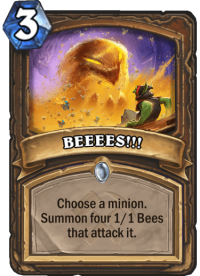
For budget players, Token Druid offers a glimmer of hope, even though its performance is weaker than it was in Rise of Shadows. BEEEES!!! is actually a good card for the archetype, so there is something new you can slot in as well.
Treant Token Druid also received nominal support in the form of Garden Gnome, but in order to make use of it, you have to include at least The Forest's Aid and Force of Nature in your deck, and the latter is an Epic card that has no other uses. Overall, Treant Token Druid does not even look like an improvement over a more budget version, so there is no real reason to build one.
There have also been attempts to resurrect Egg Druid, an aggressive variant of Token Druid, thanks to the new Serpent Egg, but so far these attempts have not been successful.
A Budget Token Druid deck looks something like this:
Therefore, Druid offers fairly little for budget players. You can build a reasonably good and cheap Token Druid and use BEEEES!!! in it, but the rest of the set is focused on supporting Quest Druid.
Hunter
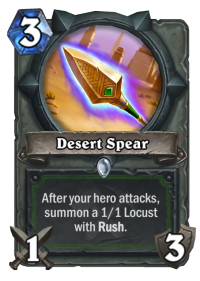
The talk of the town when it comes to Hunter is, of course, Highlander Hunter, another deck with a 13,000 dust price tag attached. It is followed by Quest Hunter at around 9,000 dust, and a pair of still viable old archetypes in the form of Bomb Hunter (6,500 dust) and Midrange Hunter (3,500 dust).
The new decks use the Hunter Legendary cards, Unseal the Vault (Quest Hunter) and Dinotamer Brann (Highlander Hunter), and they also include a number of other Legendary cards, so putting them together is not a cheap task.
As for the old decks, Bomb Hunter does not use any new cards whatsoever, and Midrange Hunter only grabs the excellent Desert Spear, which goes nicely in most Hunter decks, budget or full-cost. For reference, current Bomb Hunter and Midrange Hunter builds look something like these:
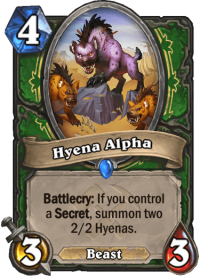
There are also some other powerful budget Hunter cards in Saviors of Uldum: Hyena Alpha is mostly used in Highlander Hunter, but it is an excellent addition to any Hunter deck that runs Secrets, including any budget builds. Pressure Plate is a new cheap Secret, and it’s also pretty good, so Budget Secret Hunter got some interesting new tools.
Hunter's Pack, on the other hand, is mostly a trap card for budget deck builders. While it provides some sweet value, it is very slow, and most budget Hunter builds need to be fast or games will slip away from their grasp. It may look attractive, and it has its upsides in slower Hunter decks, but be wary of including it in your budget builds.
Mage
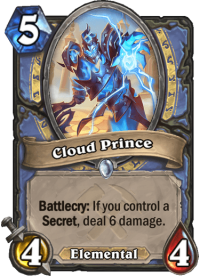
After the nerfs, Mage has been one of the least popular classes, and for good reason. Highlander Mage had great success before the nerfs, but it was hit hard and went down the ranks a fair bit. It is still a decent deck, but as the most expensive deck in the game, at times exceeding 20,000 dust, it does not have the performance to justify the cost. Mage Quest, on the other hand, is one of the weakest Quests in the game, and not worth building a deck around at all.
However, there is a small window of opportunity for budget players. Tempo Mage can be built cheaply, and it received some nice new tools in Saviors of Uldum in the form of Cloud Prince and Ancient Mysteries. Some builds also use Arcane Flakmage and Flame Ward, but as they are defensive tools, they are not an ideal fit to an aggressive deck. Tempo Mage is a low-tier deck, but it is capable of winning some games if you really want to win with Mage and lack the funds to throw into a full Highlander set.
Dune Sculptor, unfortunately, is a trap. The Mage minion pool is not strong on average, and random Mage minions are only good for losing games in weird ways.
Paladin
Paladin has more archetypes than any other class in the game: there’s Murloc Paladin, Quest Paladin, Holy Wrath Paladin, Highlander Paladin, Mech Paladin, and various rare archetypes such as Hand Paladin on top of all those. Most of them are fairly mediocre, with Murloc Paladin generally being the most successful one – but that success comes with a stunning 11,000 dust price tag for a Murloc deck.
Abusing Prismatic Lens to draw and discount Tip the Scales is the main trick of Murloc Paladin. Without those Epics, it is a mediocre aggro deck: still capable of winning some games, but far from dominant. Most builds further amplify their power with Sir Finley of the Sands, Zephrys the Great, Leeroy Jenkins, and Chef Nomi, pushing the price tag way out of reach of budget players. You can still go for Murlocs as a budget Paladin player, but expect moderate success unless you invest heavily in the big cards.
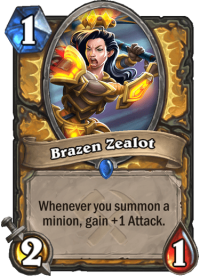
Saviors of Uldum provides superficial support for Aggro Paladin with Brazen Zealot, Sandwasp Queen, and Salhet's Pride, but don’t fall for the one-health hype. There is only even semi-successful build that uses those tools, Hand Paladin, and the card that really makes the deck tick is Mountain Giant – filling your hand with tokens in order to summon a cheap Giant is the best use for those tokens, followed by using them with Magic Carpet. Not exactly budget cards, those, but Hand Paladin is still relatively cheap at around 6,000 dust. It can be hard to find success with it though.
Pharaoh's Blessing is no better. It gives the minion some decent abilities, but at six mana it is hopelessly overpriced: it is neither a good defensive buff nor a good offensive buff, just a lackluster mix of the two that does not get the job done in any deck.
That said, Brazen Zealot is a good card. It can be combined with the Neutral Reborn minions and old Paladin Secrets to form an aggressive Secret Paladin deck that can be built cheaply.
Priest
Priest got a lot of good cards in Saviors of Uldum. The biggest issue is how to find other cards to support them in a deck.
Combo Priest is the cheapest top-tier deck at the moment. In order to be good, it really needs High Priest Amet and a pair of Psychopomps, but once you have those three expensive cards, you’re set. The rest of the deck is is all Basic, Common, and Rare cards. Sure, Bwonsamdi, the Dead is a great addition, but it is by no means mandatory.
The Priest Quest, Activate the Obelisk, is more suitable for a slower deck, and in Hearthstone, slower usually means more expensive. Quest Priest decks typically cost more than 10,000 dust and they still perform at a lower level than Combo Priest.
It looked like the expansion would support some kind of return of Zoo Priest – I last played a viable version of that in Rastakhan’s Rumble before the latest Standard rotation – but unfortunately the overall package is not strong enough. Therefore, cards such as Grandmummy and Wretched Reclaimer, which are powerful cards as such, do not have a deck they could shine in.
Rogue
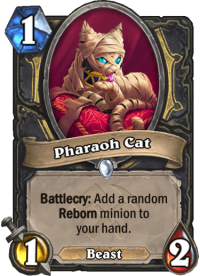
Rogue has not been very strong in Saviors of Uldum, but it is an awesome class for a budget player, because its budget or semi-budget decks perform almost as well as its full-cost decks.
Aggro Rogue or Tempo Rogue can be built mostly from Commons and Rares, and Saviors of Uldum gave these Rogue decks two sweet new cards in Pharaoh Cat and Hooked Scimitar.
Pharaoh Cat is the one-drop Rogue has been missing since Fire Fly rotated out of Standard format. Decent enough on turn one, enables combos later in the game, and generates additional resources. It is just stunning.
- 0Backstab2

- 1Deadly Poison2

- 1Pharaoh Cat2

- 2Eviscerate2

- 2Sap2

- 2Underbelly Fence2

- 3Blink Fox2

- 3EVIL Miscreant2

- 3Hooked Scimitar2

- 3SI:7 Agent2

- 4Hench-Clan Burglar2

- 4Vendetta2

- 5Crazed Chemist2

Furthermore, Quest Rogue is one of the cheapest Quest decks. Most of its support pieces are from Saviors of Uldum, and they are not too expensive: Pharaoh Cat, Clever Disguise, and Bazaar Mugger are easy to come by, and the earlier Quest support cards Pilfer, Blink Fox, and Hench-Clan Burglar are all Commons. You obviously need the Quest itself, Bazaar Burglary, and it is highly advisable to have Tess Greymane as well, but those are the only mandatory expensive pieces in the deck.
Rogue received one of the strongest sets of cards in Saviors of Uldum from a budget perspective.
Shaman
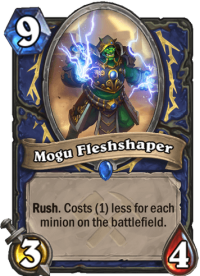
Shaman has become a popular class again in Saviors of Uldum, and it is also very affordable. Quest Shaman requires two Legendary cards, the rest of the deck is cheap, and Murloc Shaman can be built with no Legendary cards at all.
Quest Shaman uses most of the cheap new Shaman cards: Weaponized Wasp, EVIL Totem, Mogu Fleshshaper, and Sandstorm Elemental all play key roles in the deck. You need the Quest itself, Corrupt the Waters, of course, and you really should also have Shudderwock, but those are the only expensive pieces you need.
Especially Mogu Fleshshaper cannot be praised too much. The card is a powerhouse alone and even more so in combination with Mutate, with which it can provide removal followed up by a free eight-drop. That’s Corridor Creeper level of power right there.
Murloc Shaman can be built without any Epic or Legendary cards, but crafting a pair of Murloc Warleaders is recommended. The Neutral Murlocs from Saviors of Uldum, Murmy and Fishflinger, are important pieces of the deck, and it is hard to improve with any expensive pieces. Sure, some people manage to fit in Leeroy Jenkins or Siamat, but even those are far from mandatory.
Warlock
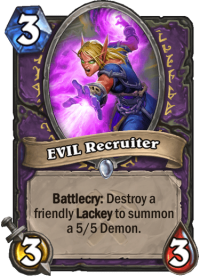
Saviors of Uldum mostly supports one Warlock archetype: Zoolock. This can be good news for a budget player, because Zoolock is the cheapest Warlock archetype available. Most meta builds use some expensive cards, such as Diseased Vulture, Magic Carpet, Leeroy Jenkins, and Sea Giant, but it is possible to build a good Warlock deck with Lackey synergy cards and Reborn minions without using any expensive pieces.
EVIL Recruiter is an insanely powerful card, and all the Lackey generators that you need for it – EVIL Cable Rat, EVIL Genius, and Sinister Deal – are Common cards, so the Lackey package is both powerful and cheap.
Neferset Thrasher, unfortunately, is not powerful alone. It really needs Diseased Vulture to shine. Together, they are a great fit to a Zoolock deck, but without the Vulture, the Thrasher is better left unused.
The Warlock Quest, Supreme Archaeology, is not strong even in a full-cost deck, and has no budget applications at all.
Warrior
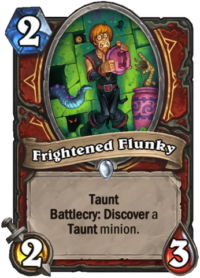
Warrior is not exactly known for being an affordable class. The main Warrior archetypes, Control Warrior and Bomb Warrior, remain very expensive and cost more than 10,000 dust. However, Warrior has had cheaper decks every now and then, and the current Aggro Warrior decks are at least a little more affordable at around 8,000 dust.
Saviors of Uldum gave Warrior two phenomenal cheap cards: Frightened Flunky and Restless Mummy are awesome cards for multiple archetypes, even after the Discover nerf that removed class card weighting from Discover effects. It is still difficult to build a truly budget Warrior deck, because budget Aggro Warrior lacks just a little bit of punch to be able to finish games. Once you add in Bloodsworn Mercenary, Livewire Lance, and Leeroy Jenkins, you get a deck that can do more than just posture being threatening – it can finish off the opponents to win games.
As for the Warrior Legendary cards, Armagedillo is only useful in expensive control decks and Hack the System is not useful at all.
There Are Lots of Alternatives in the Current Meta
To sum this all up, there are lots of options, even for free-to-play players. You can build viable budget decks – real, under 2,000 dust budget decks – for multiple classes. Those can get old pretty quickly, but then there is the next tier, those 3,500 to 6,000 dust decks that are available for some classes, especially Priest, Hunter, Shaman, and Warlock. Some of them are among the best-performing decks in the game as well. There are also some decks in the 8,000 to 9,000 dust range, such as Aggro Warrior and Quest Hunter. Finally, there is a large number of decks that cost more than 10,000 dust. Even those are not completely out of reach of free-to-play players, although it can be difficult to build more than one, so any balance changes can really hurt.
In this article, I have attempted to highlight the best cheap class cards from Saviors of Uldum as well as a number of cheap and medium-cost decks that put those cards to good use. Saviors of Uldum has more good Epic cards than any previous expansion, and it also has a lot of good Legendary cards, and that has caused the cost of many top meta decks to soar to more than 10,000 dust. However, good decks still come at all price points, and some of them are still cheap.
Leave a Reply
You must be logged in to post a comment.















































































































































What’s the thinking behind Siamat in the murloc deck? Obviously its a versatile card, but I presume there’s a preferred game plan–e.g., do you want to drop it on curve as Taunt + DS to try to shelter your murlocs, or do you want to try to hold it back as a possible late game threat and/or answer?
You hit it in your initial statement. It’s a versatile card. You can break through taunts with rush, you can shelter your murlocs, you can drop it on curve as a big threat. It’s really just about experience and learning how to respond in each spot, but no need to hold on to it for some future use that will never come.
If you really do want to play a versatile answer, I had a nice climb with hagatha (the hero card) in that slot. She basically doubles your draws, because your deck is basically all minions, so you always get a murloc and a spell. Yes, the battlecry usually clears your board, but you play her in those games where you are already pretty much screwed, and it gives you a fighting chance.